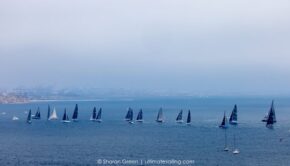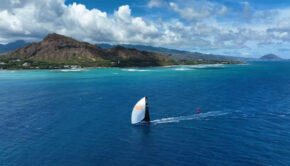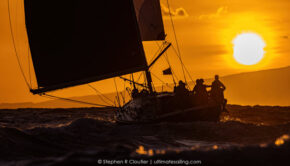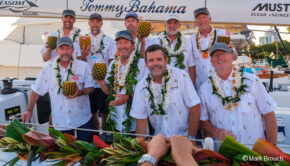Transpac: Waiting for the tradewinds
Published on July 3rd, 2023
(July 3, 2023) – With the exception of five entries that have dropped from the race and have returned to the coast, the entire Transpac fleet is now finally making good progress down the racecourse towards Hawaii.
The faster entries among the day two starters are also converging fast with the slower day on starters as shown on the tracker system and will soon be finding some passing lanes, mostly to the north of the rhumb line.
Using their satellite internet access all teams may download GRIB weather files while en route on the race. These are combined with their polar performance data and is used by routing software to help guide them on where to go on the racecourse to get the fastest possible calculated route to the finish.
Looking at the current North Pacific weather map, its apparent that the main high-pressure center has moved North and risen in pressure, from 1024 millibars late last week to 1031 millibars now.
However, the divergence and wide spacing of the isobars in the course area indicate wind pressures in the 15-20 knot ranges near the rhumb line and not the typical 20-25 knot trade winds found further south in “normal” Transpac years when the high center is closer to being on the central axis of the course.
The northeast orientation of the 1020 millibar isobar also indicates the boats will be spending a lot of time reaching on starboard tack before that orientation shifts to being more east-west and gybing to port becomes an option.
This is the reality of the starting groups on June 27 and 29, and their comments from the racecourse support this. For example, Wayne Zittel’s DK46 Cazan in Division 6 is four days into this race and asked “Where are the trade winds? Did they form a union? Are they on strike?”
While not yet in the classic downwind trade winds under clear skies, nonetheless these groups are moving 1-2 knots faster at broader angles than they were even 24 hours ago, and some have even hoisted spinnakers.
Steve Rossi on Cecil and Alyson Rossi’s Farr 57 Ho’okolohe reported “Definitely a different vibe in the air with the breeze refusing to move east of north for the time being. While we are moving along well the sun, moon, and stars would be a real treat. Also looking to get a spinnaker up and start running!”
Nearly the entire competitors in Division 4, 5, and 6 are now north of the rhumb line trying to stay in the best wind pressure on the course. This is readily apparent on the tracker when the Windy forecast switch is on: the bright green colorization used to depict 20 knots of wind envelops everyone in the early starting fleets.
In the northernmost teams on the course are the group of four J/125s in Division 4: Thomas Garnier’s Reinrag2, James Nichols’ Velvet Hammer, Standish Fleming’s Nereid, and Andrew Picel’s Arsenal. Steve Ernest’s J/145 Aimant De Fille is also north with this group. As they head west and get lifted, look for them to be hoisting spinnakers soon.
But the July 1 starters were not so lucky: not only were most of them becalmed on their first night, they also have wind that is in the light blue range of about 10-12 knots and still from the northwest ahead of the beam at 1200 PDT.
Craig Reynold’s Nelson/Marek 70 Bolt is racing in Division 3 and was a little sarcastic about their slow start when they wrote “Team BOLT is ‘happy’ to get a solid day of upwind sail tuning accomplished. Some members of the crew are confused and think they are on the East Coast.”
Roy Disney’s Andrews 68 Pyewacket, racing in the same class, was a little more upbeat with their comments: “Happy to be moving… the 95 nm 24 hour run we achieved yesterday will be crushed today.”
Even the MOD70s are starting to see some relief from the upwind conditions, with Justin Shaffer’s Orion in the lead, hitting boat speeds in the high teens, and writing: “For the first time since the start we have cracked off a bit and are now starting to transition to reaching, and later today, downwind sailing. Currently doing 22-25 kts at 80 TWA. Slow extension on Maserati through the night to a range of 18 nm or so when we lost their AIS signal.”
Meanwhile, the two teams that got away from parking with the rest of Division 1 on the first night – Manuch Moshayedi’s Bakewell White 100 Rio100 and George Hershman and Mark Comings’ Reichel/Pugh 63 Good Energy have maintained a low southerly track to steer clear of the worst of the upwind wind angles and are close-reaching at reasonable boat speeds of 12 and 10 knots, respectively. Their current tracks take them into the stronger breeze soon.
Event details – Entry list – Tracker – July 3 Roll Call
From the inaugural race in 1906, the biennial Transpac Race in 2023 is the 52nd edition with 57 entrants to take on the 2225 nm course from Los Angeles to Honolulu.
Staggered Starts
June 27 – Division 7, 8
June 29 – Division 4, 5, 6
July 1 – Division 1, 2, 3, 9
Source: TYC









 We’ll keep your information safe.
We’ll keep your information safe.